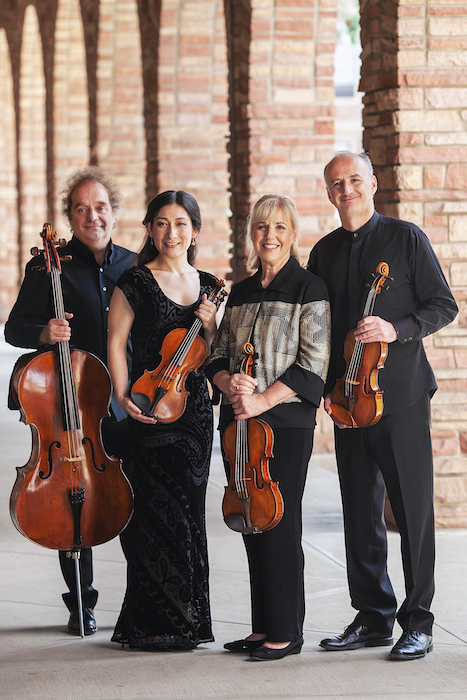A Takács Quartet in transition revisits its roots with Bartók

The Takács Quartet is in a transitional stage. With only one Hungarian founding member left, cellist András Fejér, the sound that made the group distinctive is slowly fading into a distant memory.
Given the excellence of the quartet’s newer musicians, a different kind of beautiful sound will likely replace it. Still, it was hard not to feel nostalgic at the end of Tuesday night’s concert on the Fortas series at the Kennedy Center Terrace Theater.
The last time that the Takács played a two-night traversal of the complete string quartets of Bartók here, also on the Fortas series in 2014, it left one’s ears tingling. Then, second violinist Károly Schranz and cellist András Fejér were still anchoring the quartet together, and Geraldine Walther had settled in seamlessly after replacing Roger Tapping on viola almost a decade earlier.
Now the quartet seems to be running more effortfully, like an engine with one cylinder occasionally misfiring. Harumi Rhodes, who took over as second violinist in 2018, was not always in step with first violinist Edward Dusinberre, either in terms of intonation or pacing. Walther, who will retire in June 2020 to be replaced by Richard O’Neill, played with her resplendent, chocolate tone, but some of the rapid passagework seemed out of joint.
The first experience of a Bartók quartet with Rhodes in the group, String Quartet No. 6 heard last year, had considerable promise. A complete cycle was a different matter, as the Bartók quartets, once the native language of the Takács Quartet, seemed not yet fully lived by the current formation. (A large number of listeners arriving late, delayed by traffic caused by the baseball game at Nationals Park, likely did not help the quartet’s concentration.)
Moments of brilliance still shone through. The longing, intertwined lines of the Tristan-esque first movement of String Quartet No. 1, purred seductively. Written in the wake of the composer’s infatuation with young violinist Stefi Geyer, this music seethed with secret passion. Dusinberre’s flute-like soft high notes remain immaculate, and the ensemble was generally tight in the barbaric rhythms of the third movement, especially the puckish folk music-inspired section.
String Quartet No. 3 sounded more lived in, whisper-soft at its inception and with considerable beauty of tone applied to the music’s increasingly strident dissonances and odd effects. Glissandi sighed, cello and viola ostinatos growled, interrupted by biting interjections from the violins. Fejér’s cello held the folk music imitations together aptly, a quiet drone punctuated with notes plucked by the left hand.
As the tempo picked up, there was delightful rhythmic interplay in the more barbaric sections, driven by col legno clicks and atavistic hammered clusters. The “Coda” movement began as a ghostly whisper, leading to a triumphant climax as the fast section’s music was reprised.
String Quartet No. 5 belongs to Washington in some ways, commissioned by Elizabeth Sprague Coolidge and premiered at the Library of Congress in 1935. The Takács has always played the piece exquisitely, but in this performance one could hear the group’s history with the piece, the power of its interpretation, but now somehow at a remove. There was still an admirable muscularity, the ability to turn on a dime as the composer shifts moods kaleidoscopically, veering from a sort of berserk tango to ecstatic clobbered rhythms to contrapuntal vagaries, just in the first movement.
The “night music” character of the second movement remained lustrous, mimicking insect buzzes, frog calls, other nocturnal gurglings. The lopsided folk dance of the third movement bristled with energy, a crazy canvas of vibrant tonal colors. The range of effects in the fourth movement sound like no other composer, shivering repeated notes produced by bouncing bows, triads shimmering out of the texture.
Then near the end of the fifth movement came that delightful moment of comic relief, as the Takács launched into the absurd parody of a third-rate ensemble playing a hackneyed Viennese serenade. All the pieces were there, even if at times they were not yet joined into a cohesive whole.
The Takács Quartet plays Bartók’s String Quartets Nos. 2, 4, and 6, 7:30 p.m. Wednesday. kennedy-center.org; 202-467-4600


